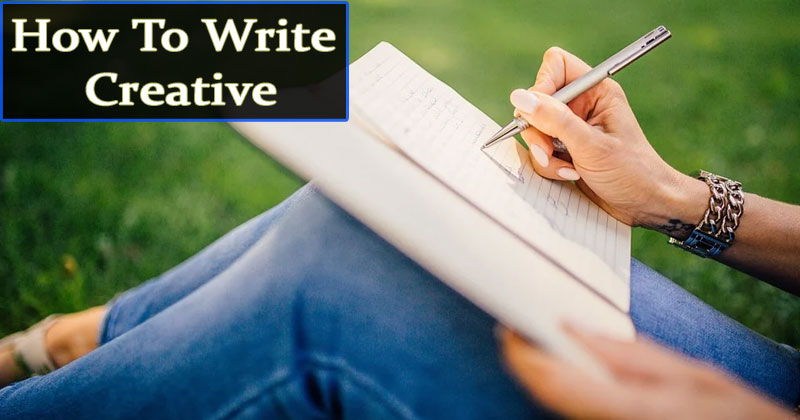
An Introduction on how to write creative
Creative writing is a very subjective and structured mode of writing. However, some universal elements are applicable no matter what genre you wish to write in. While learning how to write creative an author needs to include all of these elements: Images, voice, setting, and story, are integral to any kind of Creative Writing you wish to undertake.
Key Elements to Write Creative:
1. Images
It is through images that an author appeals to our five senses: sight, sound, smell, taste, and touch. It is important for creative writing to appeal via images. By telling the reader what you or your character saw, heard, smelled, tasted, and touched, you will make sure the readers feel as though they are there with you.
Images help you create a world your reader can enter and immerse himself in. Readers need to experience emotion through images. They do not just want to be told how a character feels or acts. As an author, one should avoid abstract words. One should stay away from generalizations and vague references.
Instead, the onus should be to use concrete details that describe something that can be seen, heard, smelled, tasted, or touched. Details should be focused and specific. Significant details are specific and also elucidates an abstraction, generalization, or judgment.
2. Voice
The language that comes naturally to you is your distinct voice, and there’s no need to tinker with it. Yet can try to be flexible and expand your vocabulary and range of style though. Your writing voice is unique to you just the way your speaking voice is singular to you. Your arrangement of words, word choice, imagery, and rhythm are all unique to you and will be familiar to others over time.

Points of view need to be sorted before you start narrating your story. Who is telling the story, who is the narrator? An author has three points of view to choose from:
- I- spoken directly from you or a character’s direct point of view. It is generally used in non-fiction personal essay types of writing. The first-person narrative allows an author to express a deep understanding of that character since you are inside their thoughts.
- You- The second-person point of view directly addresses the reader and puts the reader into the story/narrative. It’s not used very often and is used for more for a special effect.
- She/He- It is spoken by a narrator about a character. The third person is the most common mode for fiction/short story writing. This voice has a large range, from total objectivity to great intimacy.
3. Character
The most important part of creating a character is knowing and showing what that character has in mind. Characters need not be passive observers- they must want, and importantly they must act. What is your character’s deepest urge? What can’t she/he live without? Know what makes your character worried, smile, upset, embarrassed, exciting? As an author, you can lead your reader into knowing your character through minute details as it happens in real life.
You can bring a character to the reader through image, voice, action, thought, and telling the reader directly. You should use concrete, significant details to the maximum. How does he/she walk? What does he/she wear? How & What does he/she eat and drink? What is the style of his/her hair?
Characters must transform throughout the narrative. Be it a story, poem, or essay. The characters that intrigue us are the ones that change.
The quickest and best way to know someone is for that person to make an important decision. Authors also reveal what their central character has in mind. In the moments between discovering, contemplating, and deciding; characters reveal aspects of themselves. As an author, you should also elucidate your character’s family history, intentions, beliefs, and virtues.
In his quest of how to write creative, the characterization needs to be duly paid attention to.
4. Setting
Setting often expedites the wish to write. It reflects a writer’s relationship to place and time and creates a particular place and period that is necessary to imaginative writing. The setting is an integral part of the story and not merely scenery. The setting informs the reader about legacy and customs, identity, and exclusion. The writer’s style of detailing directs our understanding and experience of the setting. Readers cannot internalize a story; unless it is set within a particular place and time.
Setting means everything that supports and affects your characters. It is the props that create and sustain a character’s identity. Like image and voice, a place needs to be created by selecting concrete details. The reader should sense the setting fairly early on in a piece of writing. You can think of it as a camera, that gives the reader a wide and increasingly narrower view of the scene. You begin with a wide angle and move closer.
Setting creates the mood of the story. The mood will have some elements of time and weather-rainy or dry, shadowy or light, winter or spring, peaceful or stormy. All of these details can frame the mood for unique action and meaning to emerge. The relation to place is charged with emotion and judgment.
There may be harmony or tension between character and setting. Your characters may be at ease in the world around them, or they may be uncomfortable. When the character is comfortable, the setting and action are usually stable. And when the character is uneasy in a setting, that is when discovery and decision happen.
5. Story

Stories are about journeys- the amalgamation of the new and unfamiliar. When cultures, generations, genders, neighborhoods intersect with each other, conflict occurs in many different ways. Conflict is the foundation of a story. When it emerges, characters experience connection and disconnection. Characters transform. By the end of a story, you expect your character to have gone through a change. Thus the change occurs because the character confronts a challenge; their beliefs are shaken and tested. By the end of an important story, readers have their empathy enlarged.
Also Read – An Easy Guide On How To Write Good Poetry
Also, there is another way to look at a story. Here it is seen through conflict, crisis, and resolution; which means a beginning, middle, and end. The plot requires action, conflict, trouble. Plots also involve the protagonist and antagonist. These two opposing forces of the protagonist and antagonist keep us glued to the reading. The momentum shifts back and forth throughout the story, leaving us wondering what will happen next.
How To be a Creative writer?
The incumbent needs to keep these crucial elements in mind throughout all of his Creative Writing endeavours. Be it Images, Voice, Character, Setting, or Story; all of them should be inter-woven effectively to create a story with an impact. It is a rigorous process but totally worth the effort. If an author is introduced early on to how to write creative fundamentals and these basic story elements, he can be shaped into an effective storyteller.






